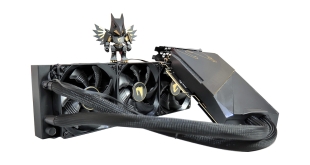
If you’re in the market for an RTX 3090 Ti, I think it is safe to say you are doing quite well for yourself. So why settle for an air-cooled card? That’s Gigabyte’s thinking at least, as today we are checking out the Aorus RTX 3090 Ti Xtreme Waterforce, complete with a 360mm all-in-one liquid cooler. But how does this monster of a GPU perform for £2100?
When we first reviewed the RTX 3090 Ti in late March, it quickly became clear that this is a GPU for the richest of PC enthusiasts – from a value perspective, it doesn't make much sense at all. But if you do have a few grand lying about and want the fastest gaming graphics card on the market, the RTX 3090 Ti is the GPU for you.
So what happens when you take that chip but chuck on a 360mm liquid cooler? That's exactly what we are going to find out today with our review of the Gigabyte Aorus RTX 3090 Ti Xtreme Waterforce. Listed for pre-order at a penny under £2100 over on Overclockers UK, it's not actually that much more expensive than some air-cooled 3090 Ti cards. Let's find out exactly what it can offer.
| RTX 3090 Ti | RTX 3090 | RTX 3080 Ti | RTX 3080 | RTX 3070 | |
| SMs | 84 | 82 | 80 | 68 | 46 |
| CUDA Cores | 10752 | 10496 | 10240 | 8704 | 5888 |
| Tensor Cores | 336 | 328 | 320 | 272 | 184 |
| RT Cores | 84 | 82 | 80 | 68 | 46 |
| Texture Units | 336 | 328 | 320 | 272 | 184 |
| ROPs | 112 | 112 | 112 | 96 | 96 |
| GPU Boost Clock | 1860 MHz | 1695 MHz | 1665 MHz | 1710 MHz | 1725 MHz |
| Memory Data Rate | 21 Gbps | 19.5 Gbps | 19 Gbps | 19 Gbps | 14 Gbps |
| Total Video Memory | 24GB GDDR6X | 24GB GDDR6X | 12GB GDDR6X | 10GB GDDR6X | 8GB GDDR6 |
| Memory Interface | 384-bit | 384-bit | 384-bit | 320-bit | 256-bit |
| Memory Bandwidth | 1008 GB/Sec | 936 GB/Sec | 912 GB/Sec | 760 GB/Sec | 448 GB/Sec |
| TGP | 450W | 350W | 350W | 320W | 220W |
Let’s first recap the exact makeup of this GPU however. The RTX 3090 Ti uses GA102 silicon, but it’s the first time we have seen a fully populated die. That means the RTX 3090 Ti incorporates 84 Streaming Multiprocessors (SMs), and thanks to Ampere’s SM structure with its two FP32 datapaths, each SM houses 128 CUDA cores, giving a total of 10752. This is an increase of 256 cores compared to the RTX 3090, an extra 2.4%.
Ampere also places one RT core, and four Tensor cores, in each SM, giving a total of 84 RT cores and 336 Tensor cores. This is accompanied by 336 texture units and 112 ROPs which are housed directly within each graphics processing cluster (GPC), with 16 ROPs per GPC, and 7 GPCs in total for RTX 3090 Ti.
Clock speed is another area where Nvidia has made improvements compared to the RTX 3090. The RTX 3090 Ti has a reference clock of 1860 MHz, a boost of 165 MHz against the RTX 3090, though of course the Xtreme Waterforce comes factory overclocked. We test real-world clock speed behaviour later in this review.
For the memory, Nvidia is using the same 384-bit bus as found with the RTX 3090. The memory allocation itself remains with 24GB of GDDR6X, but the kicker is these modules themselves have been upgraded to new 21Gbps chips. This brings total memory bandwidth up to over 1TB/s, hitting 1008GB/s to be precise.
Lastly, for total graphics power, Nvidia rates the RTX 3090 Ti for 450W, an increase of 100W, or 28.6% compared to the vanilla RTX 3090. The Xtreme Waterforce we are looking at today push this further still, with a 480W power limit.
 KitGuru KitGuru.net – Tech News | Hardware News | Hardware Reviews | IOS | Mobile | Gaming | Graphics Cards
KitGuru KitGuru.net – Tech News | Hardware News | Hardware Reviews | IOS | Mobile | Gaming | Graphics Cards



